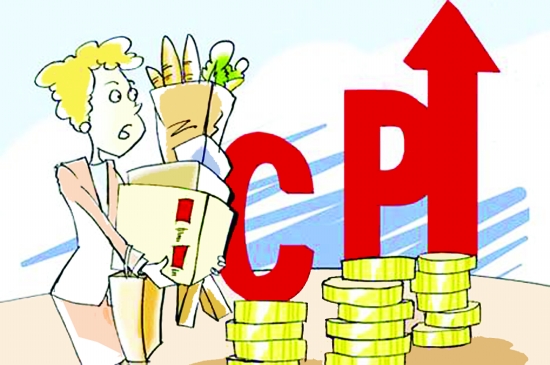China's consumer prices grew 2.3 percent in February from one year earlier, up from January's 1.8 percent, according to data from the National Bureau of Statistics on Thursday. That is the biggest rise since July 2014.
国家统计局周四发布的数据显示,2月份全国居民消费价格指数同比上涨2.3%,涨幅高于1月份的1.8%。这是自2014年7月以来的最大涨幅。
The reading beat expectations as economists from the Bank of Communications and China Merchants Bank forecast a 1.8-percent year-on-year increase for February.
这一数字也超过了交通银行和招商银行的经济学家早先曾预测的二月同比增长1.8%。
Meanwhile, producer prices slid 4.9% year-on-year in February, compared to a 5.3% fall in January. The drop was the smallest in eight months.
此外,2月份工业生产者出厂价格指数同比下降4.9%,降幅较1月份的5.3%有所缩小,这是近8个月以来的最小降幅。

HSBC analyst Qu Hongbin attributed the higher-than-expected CPI growth largely to high food inflation.
汇丰银行分析师屈宏斌认为,高于预期的CPI增长很大程度上归功于食品通货膨胀。
Food prices, which account for one-third of the CPI calculation, soared 7.3 percent year on year while non-food inflation edged up 1 percent.
食品价格在CPI计算中占三分之一,同比上涨7.3%。而非食品通胀率小幅上升1%。
Pork prices jumped sharply by 25.4 percent year on year, contributing 0.59 percentage point of CPI growth, while vegetable prices skyrocketed by 30.6 percent, accounting for 0.86 percentage point of CPI growth.
猪肉价格同比飞涨25.4%,影响CPI上涨约0.59个百分点。而蔬菜价格上涨30.6%,影响CPI上涨约0.86个百分点。
NBS statistician Yu Qiumei said that vegetable and pork prices went up due to supply shock during a cold in February and demand for pork and transportation rose around the Lunar New Year holiday, while service prices had increased along with labor costs.
国家统计局统计员余秋梅表示,蔬菜和猪肉的价格上涨,一是因为受二月寒冷天气的供应冲击,二是农历春节期间猪肉需求增加,三是春运期间交通价格上涨,还有就是因为在此期间,随着劳动力成本的增加,服务价格也随之增加。
Since this January, CPI data has been based on a new comparison base that takes into account new products and services, reflecting a change in the consumption pattern, according to the NBS. The adjustment slightly tuned down the weight of food.
根据国家统计局表示,自从今年1月份开始,CPI的数据已经基于一项新的比较基准,即将反映消费模式变化的新型产品和服务也考虑进去。这一调整稍微降低了食物所占的比重。













